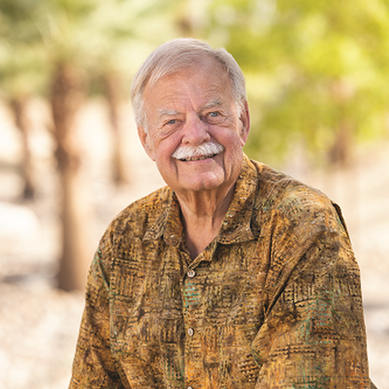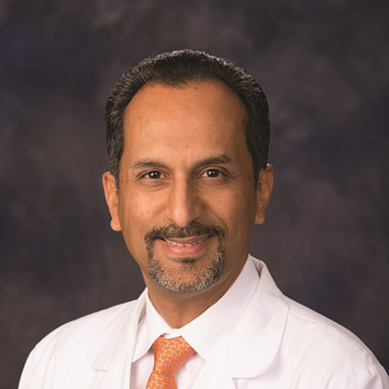When Open Heart Surgery Isn't An Option

“I noticed a tightness across my chest as a result of that exertion,” the 75-year-old Rancho Mirage resident recalls. “I’d experienced a couple of similar incidents in the past but they went away in a few seconds, so I didn’t think too much about it.
“This time, though, the chest tightness stayed,” he continues. “We came home, I sat down to relax, and when my wife returned to the room, she noticed I was pale and had my hand over my heart. My wife suggested an ambulance but since we live within two miles of the hospital, I told her we could drive there instead.”
At Eisenhower Health’s Tennity Emergency Department, Mills was quickly given an electrocardiogram (EKG) and blood tests. The results prompted the staff to admit him to the hospital, where he underwent more extensive testing, including a stress test, echocardiogram and angiogram, over the next three days.
The tests revealed that Mills had extensive blockages in all three of his major coronary arteries. Philip J. Patel, MD, Board Certified in Cardiovascular Disease, Echocardiography and Nuclear Cardiology, and President of Eisenhower Desert Cardiology Center, reviewed the test results with the Medical Center’s cardiac surgery team. They agreed that Mills was not a candidate for bypass surgery — his arteries were so severely clogged there was only one clean artery segment where a bypass graft could be attached. Given the extent of Mill’s artery blockages, it wasn’t enough of a solution. And it was too high risk.
Next, they consulted with Puneet Khanna, MD, Board Certified in Interventional Cardiology and Cardiovascular Disease. Dr. Khanna is co-director of Eisenhower’s Cardiac Catheterization laboratory and the Transcatheter Valve program.

“Usually, if there is a major blockage in one of the three major coronary arteries, we perform what’s called percutaneous coronary intervention [PCI],” Dr. Khanna continues, referring to a minimally invasive procedure in which a balloon is delivered via catheter to the site of the blockage, expanded to open the artery, and a stent is placed to prop the artery open.
“When inflating a balloon and expanding a stent in the artery, no blood is flowing in that artery — it mimics a heart attack for about 30 seconds,” he goes on. “Most patients can tolerate this if only one artery is blocked. But if multiple arteries are blocked and you shut one down, the heart doesn’t have the reserves to tolerate it. It becomes sluggish, can’t pump and grows weaker until blood pressure and oxygen levels drop, and we can’t turn it around.”
Fortunately, Eisenhower has a high-tech solution — the Impella® left ventricular assist device (LVAD). It is a miniaturized heart pump that can be temporarily implanted, via catheter, into the left side of a patient’s heart to help maintain blood flow during a high-risk PCI procedure.
“The Impella does the work of the heart, picking up blood from the left ventricle — the heart’s pumping station — to the aorta and on to the lungs, brain and other organs,” Dr. Khanna says. “It enables us to continue to perfuse the organs, oxygen levels stay up, and even if the heart stops pumping, we can continue working.”
But there was another complication in Mr. Mills’ case.
“Not only were his arteries blocked with plaque but it had hardened and calcified so that it was almost like marble,” Dr. Khanna relates. “In arteries like this, if the balloon expands, it can shatter the plaque, and that’s a major problem.”
So before placing stents, Dr. Khanna would first have to perform a minimally invasive procedure called a coronary atherectomy using a ROTAPROTM Rotational Atherectomy System. The rotoblator is a very small device shaped like a football and covered with industrial diamonds, 1.5 to 1.75mm in diameter.
“From a small incision, we thread a 10/10,000ths-of-an-inch guidewire into a blood vessel, past the blockage, and run the rotablator along it,” he explains. “This precision device has a burr at its tip that spins at 200,000 RPMs, enabling us to shave and fragment the plaque into particles smaller than blood cells, opening the blockage.
“It’s finesse work that demands a lot of tactile sense so you know precisely how hard to push or not push in order to not perforate the artery,” he adds. That tactile sense comes from experience, and Dr. Khanna has done more than 1,000 of these procedures over the past 30 years.
“Once you’ve removed the hardened plaque, then you can expand the artery with the balloon and put in stents,” he says.
Dr. Khanna explained all this to Alan and Linda Mills while Alan was still in the hospital.
“At that time, I was hesitant to say yes to this treatment,” Mills admits. “But after talking more with Dr. Khanna, I finally decided that this approach was better than just wait-and-see. I also spoke with a friend who is a cardiac anesthesiologist who, along with our children, gave me the emotional support my wife and I needed to continue with the procedure.
“I was also very impressed with Dr. Khanna and he was very reassuring,” he adds.
Mills underwent the three-and-a-half-hour procedure on March 17. He was hospitalized overnight and discharged to home the next morning.
“We normally put in one or two stents per artery and they’re one-half or one-inch long,” Dr. Khanna says. “In Mr. Mills’ case, we ended up putting in a total of eight stents between his two major arteries and a third minor artery. The third artery was treated in a second procedure on August 11. That’s almost seven inches of stents.
“We essentially did a complete rebuild of the circulation of this patient’s heart,” he adds, “and all he had to show for it were two small incisions in his groin area where the catheters were inserted.” The catheters used for balloons and stents are a little larger than a coffee straw, and the Impella’s catheter is about the size of an index finger.
In mid-July, Mills said he said he was feeling great. He swims three or four times a week and admits he gets winded — “but that’s the point of exercise,” he laughs. His wife told Dr. Khanna that she thinks his coloring and breathing are better.
“I believe this was a very effective procedure and a good option for me,” Mills continues. “Looking back, it was probably a lifesaver. Maybe I could have gone on for a while [without it] since my symptoms were so mild, but then I might have had a major heart attack and there might not have been anything they could do for me at that point.
“My experience is also a cautionary tale for people to pay attention to heart symptoms, no matter how mild they might be,” he says.
“Having this capability for treating patients who aren’t candidates for open-heart surgery puts us among the top fifty hospitals in the country for cardiovascular care,” Dr. Khanna says. “There is no margin for these patients; they have to be taken care of minimally invasively as much as possible.
“We can do that,” he adds.
To learn more, call760.346.0642, or visit Heart.EisenhowerHealth.org.



